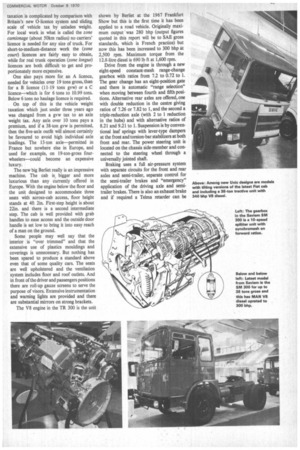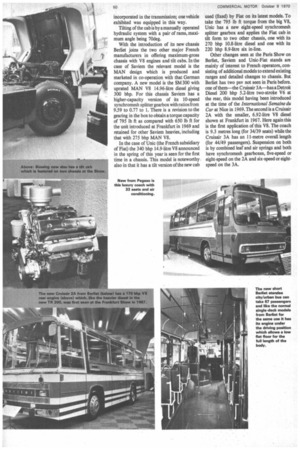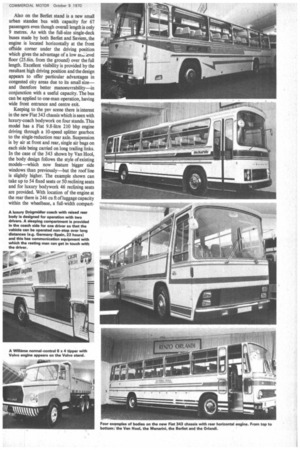Ballet strikes
Page 50

Page 51

Page 52

Page 53

If you've noticed an error in this article please click here to report it so we can fix it.
a high note• by Tony Wilding, MIMECHE, MIRTE AS FORECAST in CM's first look at the Paris Show last week, the major interest among the commercial vehicle exhibits is centred on Berliet. The most important vehicle is the new Berliet maximum-gross-weight tractive unit with tilt cab and 300 bhp V8 diesel engine, but there are also new psv and medium-weight chassis from this oldestablished French company, now owned by Citroen.
But Show significance is not limited to Berliet. Other French heavy-vehicle manufacturers in particular have important progress to display. Saviem now uses a 300 bhp V8 in one of the MAN designs it markets, and the Unic V8, uprated to 340 bhp at the beginning of this year, is seen in a chassis for the first time—one of the Unic models using the tilting version of the latest Fiat cab. Elsewhere in the Show one finds bodied examples of the new Fiat 343 rear-engine psv chassis (these complete vehicles are on the stands of Van Hool, Menarini, Orlandi and Fiat—a Heuliez body).
Two Bussing commercial vehicles are seen for the first time with tilt cabs, there are interesting 4 x 4 conversions by Sinpar, including the Ford Transit a new Pegaso luxury coach and a Willeme six-wheeler with Volvo engine. And for the first time in Paris two Hino trucks from Japan are displayed.
Just as Earls Court last month found manufacturers and operators uncertain about the future vehicles they would be allowed to operate, so the Paris exhibition, which closes on Sunday, comes at a moment when operators are awaiting news of changes in regulations—and possibly taxes. Although French makers build trucks to 38-ton limits for adjacent markets, the domestic maximum remains 35 tons, and the present hope of the industry is that news of a 38-ton—or even 40-ton—Limit may soon be given by the French authorities.
There is also talk of the less welcome possibility of higher rates for the commercial vehicle axle taxes which have been in operation for over two years now. So far, these selective taxes have not had any noticeable affect upon vehicle layout and design but if the taxes are increased steeply then we may see operators asking for vehicles which fall within the lower-rated axle weights.
The French system of licensing and taxation is complicated by comparison with Britain's new 0-licence system and sliding scale of vehicle tax by unladen weight. For local work in what is called the zone camionage (about 50km radius) no carriers' licence is needed for any size of truck. For short-to-medium-distance work the (zone court) licences are fairly easy to obtain, while for real trunk operation (zone longue) licences are both difficult to get and proportionately more expensive.
One also pays more for an A licence, needed for vehicles over 19 tons gross, than for a B licence (11-19 tons gvw) or a C licence—which is for 6 tons to 10.99 tons. Below 6 tons no haulage licence is required.
On top of this is the vehicle weight taxation which just under three years ago was changed from a gvw tax to an axle weight tax. Any axle over 10 tons pays a premium, and if a 38-ton gvw is permitted, then the five-axle outfit will almost certainly be favoured to avoid high individual axle loadings. The 13-ton axle—permitted in France but nowhere else in Europe, and used for example, on 19-ton-gross fourwheelers—could become an expensive luxury.
The new big Berliet really is an impressive machine. The cab is bigger and more luxurious than any currently offered in Europe. With the engine below the floor and the unit designed to accommodate three seats with across-cab access, floor height stands at 411 2in. First-step height is about 22in. and there is a second intermediate step. The cab is well provided with grab handles to ease access and the outside door handle is set low to bring it into easy reach of a man on the ground.
Some people may well say that the interior is over trimmed" and that the extensive use of plastics mouldings and coverings is unnecessary. But nothing has been spared to produce a standard above even that of some quality cars. The seats are well upholstered and the ventilation system includes floor and roof outlets. And in front of the driver and passengers positions there are roll-up gauze screens to serve the purpose of visors. Extensive instrumentation and warning lights are provided and there are substantial mirrors on strong brackets.
The V8 engine in the TR 300 is the unit shown by Berliet at the 1967 Frankfurt Show but this is the first time it has been applied to a road vehicle. Originally maxi mum output was 280 bhp (output figures quoted in this report will be to SAE gross standards, which is French practice) but now this has been increased to 300 bhp at 2,500 rpm. Maximum torque from the 12.8-litre diesel is 690 lb ft at 1,600 rpm.
Drive from the engine is through a new eight-speed constant-mesh range-change gearbox with ratios from 7.2 to 0.72 to 1. The gear change has an eight-position gate and there is automatic "range selection" when moving between fourth and fifth positions. Alternative rear axles are offered, one with double reduction in the centre giving ratios of 7.26 or 7.82 to 1, and the second a triple-reduction axle (with 2 to 1 reduction in the hubs) and with alternative ratios of 8.21 and 9.21 to 1. Suspension is by conventional leaf springs with lever-type dampers at the front and torsion-bar stabilizers at both front and rear. The power steering unit is located on the chassis side-member and connected to the steering wheel through a universally jointed shaft.
Braking uses a full air-pressure system with separate circuits for the front and rear axles and semi-trailer, separate control for the semi-trailer brakes and "emergency" application of the driving axle and semitrailer brakes. There is also an exhaust brake and if required a Telma retarder can be incorporatedincorporated in the transmission; one vehicle exhibited was equipped in this way.
Tilting of the cab is by a manually operated hydraulic system with a pair of rams, maximum angle being 70deg.
With the introduction of its new chassis Berliet joins the two other major French manufacturers in offering maximum-gross chassis with V8 engines and tilt cabs. In the case of Saviem the relevant model is the MAN design which is produced and marketed in co-operation with that German company. A new model is the SM 300 with uprated MAN V8 14.96-litre diesel giving 300 bhp. For this chassis Saviem has a higher-capacity version of its 10-speed synchromesh splitter gearbox with ratios from 9.59 to 0.77 to 1. There is a revision to the gearing in the box to obtain a torque capacity of 795 lb ft as compared with 650 lb ft for the unit introduced at Frankfurt in 1969 and retained for other Saviem heavies, including that with 275 bhp MAN V8.
In the case of Unic (the French subsidiary of Fiat) the 340 bhp 14.9-litre V8 announced in the spring of this year is seen for the first time in a chassis. This model is noteworthy also in that it has a tilt version of the new cab used (fixed) by Fiat on its latest models. To take the 795 lb ft torque from the big V8, Unic has a new eight-speed synchromesh splitter gearbox and applies the Fiat cab in tilt form to two other chassis, one with its 270 bhp 10.8-litre diesel and one with its 220 bhp 8.9-litre six in-line.
Other changes seen at the Paris Show on Berliet, Saviem and Unic-Fiat stands are mainly of interest to French operators, consisting of additional models to extend existing ranges and detailed changes to chassis. But Berliet has two psv not seen in Paris before. one of them—the Cruisair 3A—has a Detroit Diesel 200 bhp 5.2-litre two-stroke V6 at the rear, this model having been introduced at the time of the International Sernaine du Car at Nice in 1969. The second is a Cruisair 2A with the smaller, 6.92-litre V8 diesel shown at Frankfurt in 1967. Here again this is the first application of this V8. The coach is 9.3 metres long (for 34/39 seats) while the Cruisair 3A has an 11-metre overall length (for 44/49 passengers). Suspension on both is by combined leaf and air springs and both have synchromesh gearboxes, five-speed or eight-speed on the 2A and six-speed or eightspeed on the 3A.
Also on the Berliet stand is a new small urban standee bus with capacity for 67 passengers even though overall length is only 9 metres. As with the full-size single-deck buses made by both Bediet and Saviem, the engine is located horizontally at the front offside corner under the driving position which gives the advantage of a low al..; ievel floor (25.6in. from the ground) over the full length. Excellent visibility is provided by the resultant high driving position and the design appears to offer particular advantages in congested city areas due to its small size— and therefore better manoeuvrability—in conjunction with a useful capacity. The bus can be applied to one-man operation, having wide front entrance and centre exit.
Keeping to the psv scene there is interest in the new Fiat 343 chassis which is seen with luxury-coach bodywork on four stands. This model has a Fiat 9.8-litre 210 bhp engine driving through a 10-speed splitter gearbox to the single-reduction rear axle. Suspension is by air at front and rear, single air bags on each side being carried on long trailing links. In the case of the 343 shown by Van Hool, the body design follows the style of existing models—which now feature bigger side windows than previously—but the roof line is slightly higher. The example shown can take up to 54 fixed seats or 50 reclining seats and for luxury bodywork 46 reclining seats are provided. With location of the engine at the rear there is 246 cu ft of luggage capacity within the wheelbase, a full-width comport








































































































